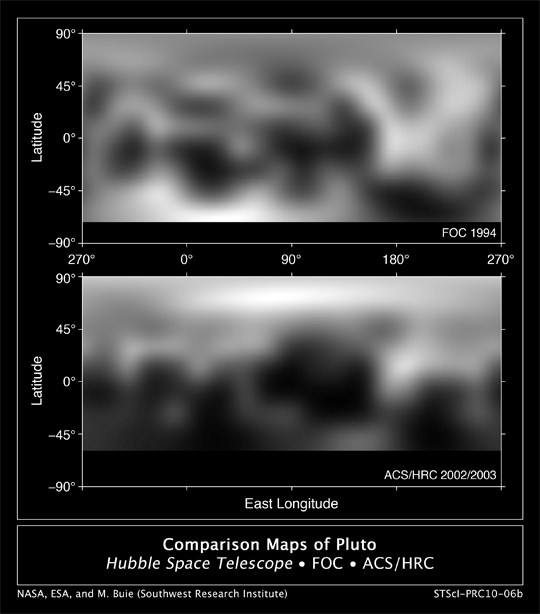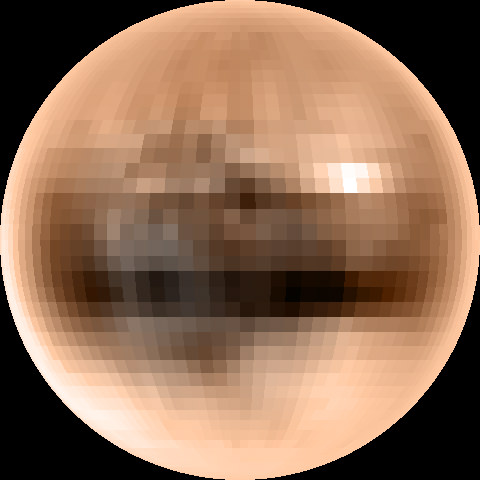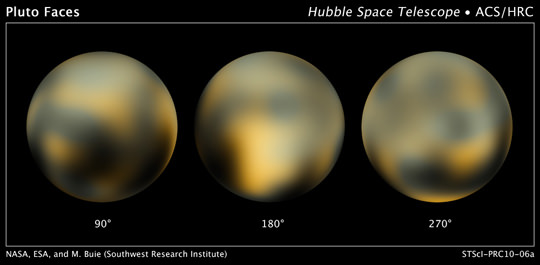Pluto-philes (and astronomers, too) have always bemoaned the fact that the best image of the principal dwarf planet wase just a fuzzy, pixelized haze. Bemoan no more. The most detailed look to date of the entire surface of Pluto has been constructed from hundreds of images taken by the Hubble Space Telescope. The images were taken during 2002 to 2003, and it took four years of computer crunching and software tweaking to create the global images. Surprisingly, the images show Pluto changed noticeably during the two-year photo shoot; the dwarf planet’s color became “redder,” and astronomers could see Pluto’s ice sheets were shifting.
“These Hubble pictures represent a true-color appearance of what you would see if you were near Pluto, comparable to looking at our own Moon with the naked eye,” said principal investigator Marc Buie of the Southwest Research Institute. “We now know we’re looking at something that has the biggest surface changes of any object in our solar system.”
The pictures show nitrogen ice growing and shrinking, getting brighter in the north and darker in the south.
Buie and planet hunter Mike Brown from Caltech introduced the Hubble images during a teleconference with reporters today, and emphasized how surprised they were with the changes seen on Pluto in just a relatively short period of time. Even accounting for seasonal changes, seasons can last 120 years in some regions of Pluto.

They said the images underscore that Pluto is not simply a ball of ice and rock but a dynamic world that undergoes dramatic atmospheric changes. While they believe the changes are driven by the seasons, it may mostly come from how quickly things can change on Pluto. The seasons are propelled as much by the planet’s 248-year elliptical orbit as its axial tilt — unlike Earth where the tilt alone drives seasons. On Pluto spring transitions to polar summer quickly in the northern hemisphere because Pluto is moving faster along its orbit when it is closer to the Sun.
“If Earth had such an extreme orbit, and we were experiencing a nice springtime day with 60-70 degree F temperatures, as the orbit changed it could suddenly drop to -90 degrees F,” said Brown.
There is also a mysterious bright spot on the center of Pluto, which has been observed in earlier images. But the spot is unusually rich in carbon monoxide frost.
Click here to see a video of Pluto rotating.
The astronomers said Pluto is so small and distant that the task of resolving the surface is as challenging as trying to see the markings on a soccer ball 40 miles away. Buie said we won’t have a better look at Pluto until the New Horizon’s spacecraft is six months away from the dwarf planet in 2015.
The images were taken with the Advanced Camera for Surveys on HST, and the 348 images taken in 2002 and 2003 were the last ones taken of Pluto with high enough resolution to be useful. “I had time allocated two years ago to look at Pluto, which came just three or four weeks after the high resolution camera failed,” Buie. “That was very disappointing.”
But the images do show Pluto is significantly redder than it had been for the past several decades. Astronomers use the word “red” to mean it reflects more red light than blue or green light. To the human eye, Pluto has a yellowish-orange color, and is about 20% redder than it used to be. “It’s not as red as the surface of Mars, but more red than Io,” Buie said.
Red is usually associated with carbon. The astronomers said there is also methane, which is not usually stable in an environment like Pluto’s.
“This business about the color change had me scared for awhile,” Buie confessed. “I got the result years ago, but it was so hard to understand and believe. I’m still nervous about it. It could be that I completely screwed this up, but I can tell you Charon is on the same images, and Charon has the same color throughout but Pluto changed. I don’t’ know how the camera system on HST could have given me the wrong colors on Pluto.”

Someone suggested that Pluto is reddening because of its recent demotion from full planethood. “Yes, people have said that Pluto is mad at me,” said Brown, who has the nickname of the “Pluto killer” because he discovered other Kuiper Belt objects which led to the new class of dwarf planets.
“For a long time Pluto was this lonely oddball that we didn’t have anything else to compare it with,” said Brown. “Understanding this all as a new class of objects is a much more interesting way of looking at the solar system and it is quite a bit of fun, too.”
More information from Buie’s webpage on the Pluto images.
The paper about the images isn’t posted online yet, but it will be up on this webpage soon.
Source: Conference call.
Additional images and info from NASA


Pluto is one of a new class of PLANETS in our solar system, the dwarf planets that are planets because they are large enough to be in hydrostatic equilibrium but of the dwarf subcategory because they are not large enough to gravitationally dominate their orbits. In fact, these pictures that show Pluto to be a dynamic world reinforce its similarities to the larger planets. Most asteroids and KBOs do not have geological processes and weather.
Broadening the category of planets to allow for more and more subcategories and understanding dwarf planets as one of these subcategories about which we are just now learning is the really much more interesting way of looking at the solar system.
I use the name “Plutogirl” online, and I’m a redhead. Maybe red is the color symbolizing the Pluto resistance. 🙂
Pluto is about to blow up. We better go back to when it was a planet! 😉
Very interesting find; global warming throughout the solar system?
Soooo looking forward to the New Horizons arrival.
I’m with ZomZom, I can’t wait until 2015 and New Horizon’s proximity to Pluto. Who knows what additional wonderful images we’ll see.
The thin atmospheres (IIRC too rarefied to have anything but an exosphere with thermosphere properties contacting the parent body surface) bring all sorts of exciting data. Who colored Pluto’s hair?
That would be amazing if true. Spherical Kuiper objects are glorified (differentiated) comets, so naively they should change less than undifferentiated and heated near sun visitors of the same class. Maybe that atmosphere does make a difference.
Speaking of glorified comets, sorry laurele, but this layman don’t think these objects are best categorized as planets just because they are large and thus differentiated. In biology you use phylogeny to establish kinship, and that measure brings all sorts of benefits in understanding populations and relationships among traits.
AFAIU bodies in the protoplanetary disk accrete by collisions. The difference between planets and comets is that the former weren’t ejected out of the disc to form the scattered disc (and subsequently the Kuiper belt) and Oort cloud. They are different populations with different characteristics. The ability to gravitationally dominate their orbits is among those.
[Albeit I guess there would be a very remote chance that a real big Triton analogue would migrate back in some systems to take its place as gravitationally dominating “planet” along with the others. There is still an order of magnitude difference in mass between our smallest planet (Mercury) and our largest “comet” (Triton; it’s heavier than Eris), and that is discounting the fact that Mercury had its volatiles burnt off.]
Of course having undergone the same differentiation process these objects share more traits with planets than their undifferentiated kins do. But that isn’t the whole story.
Pluto is definitely known to be globally warming along with Earth, albeit the forcing, also known, differ.
For Pluto the forcing is known to be solar (due to a large orbit eccentricity and its now nearing the Sun). I guess that knowledge stretches back a couple of decades.
For earth the forcing is known to be AGW. That knowledge goes back to at least IPCC 2007, which could test that to climatologists satisfaction.
I dunno about the remaining 7 planets and the myriad of smaller bodies. Depending on your temperature resolution I would say that it’s a fair chance that at any given time half of them would have warming climate and half have cooling. (For most of those, as airless bodies, “climate” would be surface temperature over climatologists 30 years, I guess.)
For eccentric orbiters like Pluto that would even be individually factual.
Nitpicking myself:
“For eccentric orbiters like Pluto that would even be individually factual.”
Unless they are orbiting the Sun much faster than the 30 year average would be affected from; there’s bound to be a cut-off in there somewhere.
“Pluto is definitely known” Seems I have messed up “suspected” with “known”. And surely surface temperatures have been estimated by know, but for 30 years? Have more coffee, it’s on me! 😀
@ SuperKevin:
“Very interesting find; global warming throughout the solar system?”
Earth gets greener when it changes from winter to spring, so does change the colour of Pluto when it moves toward spring.
I think it was a rush to demote Pluto from being a planet, where I suppose the other “plutoids,” such as Sedna would also be a planet. Terrestrial planets and jovian gas giants are very different objects, yet we consider them both to be planets. Plutoids should be another subclassification of planets. A planet as I think of it is any mass that is sufficient to gravitationally assume a spherical shape. but that is too small to initiate nuclear fusion in its core.
I was under the impression that Pluto was approaching its eccentricity derived autumn, and not spring. Yet clearly there are some chemical changes or changes in distrubutions in chemistry on the surface in response to small heat changes in this cryrogenic state.
LC
Don’t discount Charon’s influence. It’s quite large in relation to it’s parent, so there may be some gravity-related disturbances.
I can’t wait for New Horizons to get there and snap some pics!!!
LC you are right, it is moving away from the sun so it gets colder. My mistake.
LC wrote:
“A planet as I think of it is any mass that is sufficient to gravitationally assume a spherical shape. but that is too small to initiate nuclear fusion in its core.”
I agree with this, except the object should not be orbiting another non-stellar object, such as another planet. Otherwise the Moon would be a planet.
Also, I’m not sure where to draw the line for objects orbiting brown dwarfs, as brown dwarfs themselve are a median between gas giants and stars.
I also think that there can be a better classification system for types of planets. It might even be better to have an Alpha-numeric system similar to stars (OBAFGKMLT).
No doubt the list should be open as we will find weird worlds around other stars.
Whether or not the planet has cleared it’s orbital neighborhood doesn’t seem to make sense to me. For example, Jupiter has lots of trojans, so technically, it’s oribt isn’t clear. A young planet may not have had the time to clear it’s orit anyway.
We can’t really expect to universe to nicely fit into our preconcieved definitions anyway – it is us that must adapt. Pluto is there regardless of what we call it.
Dark Gnat:
“Whether or not the planet has cleared it’s orbital neighborhood doesn’t seem to make sense to me. For example, Jupiter has lots of trojans, so technically, it’s oribt isn’t clear. A young planet may not have had the time to clear it’s orit anyway”
I think the determining factor is if the object by mass dominates the mass of all other objects in the orbital path, not whether the orbit is clear. Jupiter clearly dominates by mass in its orbit. Pluto doesnt even come close to dominating in terms of mass.
Every astronomical body is unique, and no two planets are equivalent. Classification systems are inventions for our use. One thing we humans do is to categorize things.
LC
I am all for it to call Pluto not a planet, although the classification scheme of the IAU is a little bit weird.
If the earth would be at Pluto’s distance, it wouldn’t be a planet, either 😉 .
Still, if Pluto would still be a planet, we would have a lot more by now. I don’t want to learn new planet names every week 😉
I just checked pluto was its closest to the Sun around beginning of 1990. So it is clearly becoming spring.
One good explanation that I saw was it is a delayed effect from the summer where it needs time to warm the deep frozen planet and so only now got the planet enough energy to have interesting interactions.
I wonder how long the exposure times will be for the images to be taken. Will there be streaking? It’s dim out there and NH will be zooming by on it’s way out of the solar system.
Olaf:
I think Pluto is now farther away from the Sun than Neptune, which means it’s already past it’s closest approach.
However, the delayed “summer” might be a good explanation. Even on Earth, the seasons star a bit after the solstices and equinoxes (is that correct plural form?), and Saturn appears to be a little behind as well.
When you stand next to a heater, you don’t get hot immediately, and you still feel the warm spot for a few minutes after you walk away.
As for what a “Planet” is, I do think the IAU may have jumped the gun. For example, they state that a planet must be in orbit around the sun, so exoplanets are disqualified if you want to be anal about it. 😉
How would exoplanets be disqualified, as they orbit around their host stars (suns), correct?
Maybe that’s why we call them exo-planet. Another category of planet, just like dwarf planet, and means that the planet orbits another star 😉
@Torbjorn Larsson I strongly disagree with your statement that spherical Kuiper Belts are “glorified comets.” Spherical KBOs have less in common with comets than with the planets. They are much larger–no comet is anywhere near Pluto’s size; they are about 75 percent rock, and their orbits are far less elliptical than those of comets–they never come into the inner solar system near the Sun the way comets do. Comets lose mass every time they approach the Sun. Geological differentiation is a crucial difference as well. No comet is geologically differentiated or has active geology and weather.
Planet formation is still poorly understood. Some of the large planets are believed to have migrated from the place they initially formed early in the solar system’s history. In one exoplanet system, a giant planet has a very comet like orbit. We cannot be certain that all types of planets formed in the same manner.
There is no reason an object must gravitationally dominate its orbit to be considered a planet. For small planets like Pluto and Eris, the designation of dwarf planet, if made a subclass of planet, would tell us both that these objects are spherical and that they are too small to dominate their orbits. But again, that doesn’t make them not planets.
Also, any object brought close enough to its parent star will develop a tail due to sublimation. Put Earth 30 times closer to the Sun than it is now (the equivalent of putting Pluto in Earth’s orbit), and it will develop a tail as well.
You admit that “Of course having undergone the same differentiation process these objects share more traits with planets than their undifferentiated kins do.” Doesn’t this mean that classifying these objects with comets is problematic? Just because an object has one or two characteristics of another object doesn’t make it that object (i.e. the large exoplanet in a comet like orbit around its star is not a comet). Blurring such important distinctions is a disservice in any definition.
Surely seasons are dependant on axial tilt not proximity to the sun. So whether or not Pluto is moving towards perihelion or aphelion that doesn’t determine its “spring” or “autumn”, does it? Or does it depend on where the observer is on the surface of the object? Earth is at perihelion in early January and we in th enorth call it winter while my relatives in Aus and NZ call it summer.